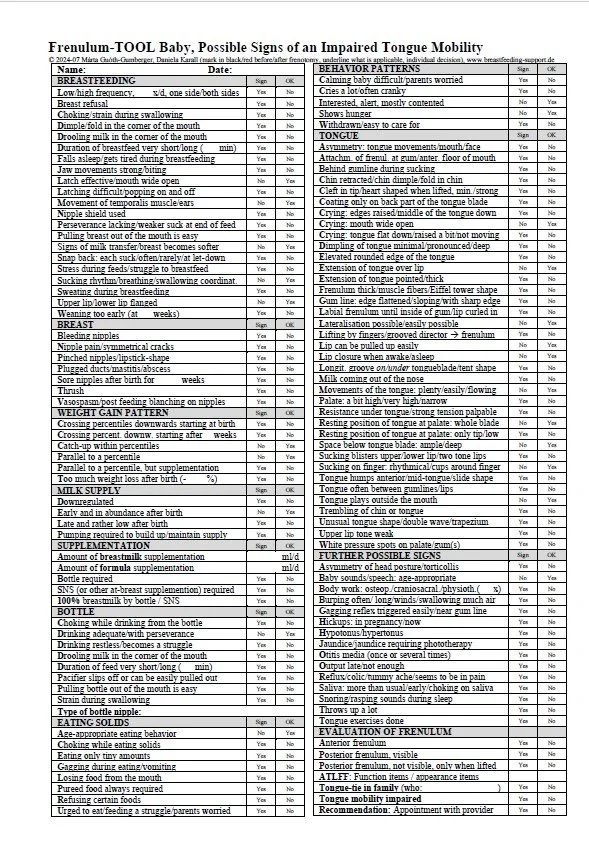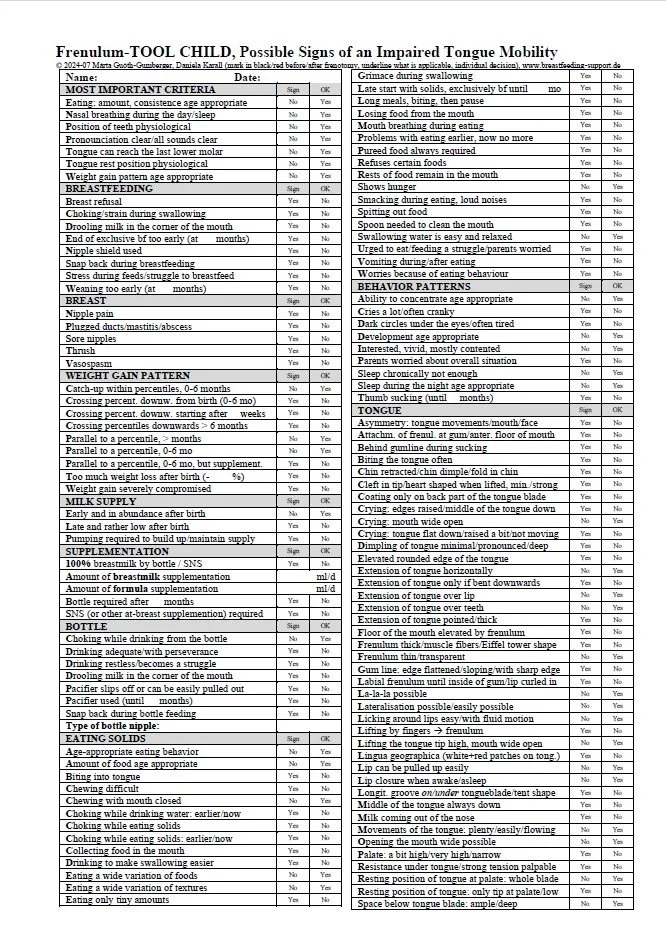Literature about Breastfeeding for Professionals
Back to the articles sorted according to topics or categories.
FOR PROFESSIONALS: The Program LACTDOC for Documentation and Weight Monitoring of Breastfed Babies helps to document the individual growth curves of babies with minimal effort. Enter gender, date and the corresponding weight, length and head circumference - the program LACTDOC (for Excel) automatically plots the individual growth curve into the WHO Standards (see the video Plotting weight curves with LACTDOC). LACTDOC allows for entering data both in gram and pounds, in cm and inches. The baby’s weight curve can be labeled with legends that depict the feeding method and the most important measures. This will improve your overview of the situation, leads to clarity what measures to suggest and allows to verify the effectiveness of the measures recommended. The attached booklet summarizes the interpretation of weight curves (see Videos on Evaluating Weight in the first months).
Booklet “Evaluation of Growth Curves”, 24 pages, CD with LACTDOC, system requirements: Excel needs to be installed on Windows or Mac. Alternatively, LACTDOC is also available as LACTDOC as DOWNLOAD.
This paper describes how breastfeeding can be protected even if supplementation is necessary. When is supplementation of a breastfed baby really necessary? In an easy and reliable way, this can be determined with help of the weight curve. How to supplement, which device to choose, which quantities are important questions. At-breast supplementation is possible with different devices and protects breastfeeding. How can you evaluate the impact of supplementation with the weight curve? Baby-led reduction of supplements with visual assessment of the weight curve is time-saving and reliable.
8 pages, Lactation & Breastfeeding, 2021-2
For a free download from the webpage of Lactation & Breastfeeding click here: How to Supplement to Protect Breastfeeding
FOR PROFESSIONALS: The article provides a first introduction to the topic of tongue-tie and breastfeeding. Anterior as well as a posterior tongue-tie can cause the same limitations in the mobility of the tongue and similar follow-on problems. Support and treatment are the same for both. Appearance of the tongue, typical observations in case of tongue-tie, typical weight curves, counselling, follow-up care and long-term outcome are described in this article.
4 pages, Lactation & Breastfeeding, 2016/2 (pp 14-17) free Download, © Márta Guóth-Gumberger and Daniela Karall
FOR PROFESSIONALS: Midwives and Lactation Consultants IBCLC sometimes encounter situations when breastfeeding problems are not improved even after skilled lactation support and modifications. In these situations, it makes sense to evaluate the tongue mobility and the overall situation in detail. The “Frenulum-TOOL Baby” serves for assessing and documenting eventual signs of an impaired tongue mobility for the age between 0 to 12 months. The detailed clinical assessment includes breastfeeding, condition of the breasts, weight gain pattern, milk production, the amount of an eventual supplementation, bottle feeding, eating solids and behavioral patterns together with tongue function and further signs.
The ”Frenulum-TOOL Baby” helps to decide whether to suggest an appointment with a frenotomy provider or not. Combined with the weight curve of the baby and the ATLFF (Assessment Tool for Lingual Frenulum Function of A. Hazelbaker) this evaluation form is useful for the communication with the provider. From time to time, a revision is made based on further evidence and experience.
The Frenulum-TOOL Baby is available as Download. You will receive a secure link which is valid until 24 hours after the first download.
© 2024-07 Márta Guóth-Gumberger, Daniela Karall
FOR PROFESSIONALS: Some toddlers, older children and school-age children encounter problems with general health , dental health , airway health and speech which are not improved even after skilled support and modifications. In these situations, it makes sense to evaluate the tongue mobility and the overall situation in detail. The “Frenulum-TOOL CHILD” serves for assessing and documenting eventual signs of an impaired tongue mobility for these children. The detailed clinical assessment includes the breastfeeding situation as a baby, weight gain patterns as baby and later, bottle feeding, eating solids, health symptoms, dental health symptoms and speech issues together with tongue function and further signs.
The ”Frenulum-TOOL CHILD” helps to decide whether to suggest an appointment with a frenotomy provider or not. This evaluation form is useful for the communication with the provider. If a frenotomy is necessary, the tool is also helpful for documenting changes. From time to time, a revision is made based on further evidence and experience.
The Frenulum-TOOL CHILD is available as Download. You will receive a secure link which is valid until 24 hours after the first download.
© 2024-07 Márta Guóth-Gumberger, Daniela Karall
FOR PROFESSIONALS: Midwives and Lactation Consultants IBCLC sometimes encounter situations when breastfeeding problems are not improved even after skilled lactation support and modifications. In these situations, it makes sense to evaluate the tongue mobility and the overall situation in detail. The “Frenulum-TOOL Baby SPANISH” serves for assessing and documenting eventual signs of an impaired tongue mobility for the age between 0 to 12 months. The detailed clinical assessment includes breastfeeding, condition of the breasts, weight gain pattern, milk production, the amount of an eventual supplementation, bottle feeding, eating solids and behavioral patterns together with tongue function and further signs.
The ”Frenulum-Lingual-TOOL Baby SPANISH” helps to decide whether to suggest an appointment with a frenotomy provider or not. Combined with the weight curve of the baby and the ATLFF (Assessment Tool for Lingual Frenulum Function of A. Hazelbaker) this evaluation form is useful for the communication with the provider. From time to time, a revision is made based on further evidence and experience.
The Frenulum-TOOL Baby SPANISH is available as Download. You will receive a secure link which is valid until 24 hours after the first download.
© 2025-01 Márta Guóth-Gumberger, Daniela Karall
FOR PROFESSIONALS: Supporting newborns after birth, you may see problems with breastfeeding initiation, but you do not have the time and possibility to intensively study tongue mobility. This Pre-Screening for Lingual Frenulum AFTER BIRTH enables you after short familiarization to decide whether to send the baby to a professional who has extended experience with tongue mobility and tongue-tie or not.
A laminated colour print of the Pre-Screening is helpful in the delivery room, for home birth, in a delivery suite, in the NICU or for home visits. A black and white print is suitable for documentation for each baby and for communication with other professionals. It can be filled in less than a minute.
The Pre-Screening has been presented for the first time in 2020 in German and is being validated during its use. Your feedback is helpful. The Pre-Screening has the goal that babies who need tongue-tie treatment get access to it early so that breastfeeding and development can evolve age appropriately, but also that unnecessary worries are avoided in babies with normal tongue mobility.
The Pre-Screening is available as Download. You will receive a secure link which is valid until 24 hours after the first download.
© 2022-04, Márta Guóth-Gumberger, Daniela Karall, 2 pages, in colour
FOR PROFESSIONALS: Supporting babies and older children you may see problems with breastfeeding initiation, breastfeeding, weight gain, eating solids, speech or teeth. You might not have the time and possibility to intensively study tongue mobility. This Pre-Screening for Lingual Frenulum BABY AND CHILD enables you after short familiarization to decide whether to send the baby to a professional who has extended experience with tongue mobility and tongue-tie or not.
A laminated colour print of the Pre-Screening is helpful for breastfeeding counselling, home visits, children’s wards, pediatric offices, dentists, orthodontists, speech therapists and other professionals. A black and white print is suitable for documentation for each baby or older child and for communication with other professionals. It can be filled in less than a minute.
The Pre-Screening has been presented for the first time in 2020 in German and is being validated during its use. Your feedback is helpful. The Pre-Screening has the goal that babies who need tongue-tie treatment get access to it early so that breastfeeding initiation, eating behaviour, speech development and dental health can evolve age appropriately, but also that unnecessary worries are avoided in babies and older children with normal tongue mobility.
The Pre-Screening is available as Download. You will receive a secure link which is valid until 24 hours after the first download.
© 2022-04, Márta Guóth-Gumberger, Daniela Karall, 2 pages, in colour
The film describes the long way of a family with a baby with oral clefts – including breastfeeding, pumping, finger-feeding, the Supplementary Nursing System (SNS) and various other devices until he was able to breastfeed without any aids after surgery of the clefts. The film addresses expectant parents, parents who unexpectedly had a baby with a cleft, grandparents and professionals.
DVD, 25 minutes; the chapters can be selected individually.
Languages: German, French, Italian, Spanish, English









FOR PROFESSIONALS: The Program LACTDOC for Documentation and Weight Monitoring of Breastfed Babies helps to document the individual growth curves of babies with minimal effort. Enter gender, date and the corresponding weight, length and head circumference - the program LACTDOC (for Excel) automatically plots the individual growth curve into the WHO Standards (see the video Plotting weight curves with LACTDOC). LACTDOC allows for entering data both in gram and pounds, in cm and inches. The baby’s weight curve can be labeled with legends that depict the feeding method and the most important measures. This will improve your overview of the situation, leads to clarity what measures to suggest and allows to verify the effectiveness of the measures recommended. The attached booklet summarizes the interpretation of weight curves (see Videos on Evaluating Weight in the first months).
LACTDOC is available as Download. You will receive a secure link which is valid 24 hours after the first download of the zip-file LACTDOC. It contains the Excel-File LACTDOC, a short instruction, the booklet “Evaluation of Growth Curves”, 24 pages, and a table with Evaluation Criteria. System requirements: Excel needs to be installed on Windows or Mac. Alternatively, LACTDOC is also available as LACTDOC on CD.